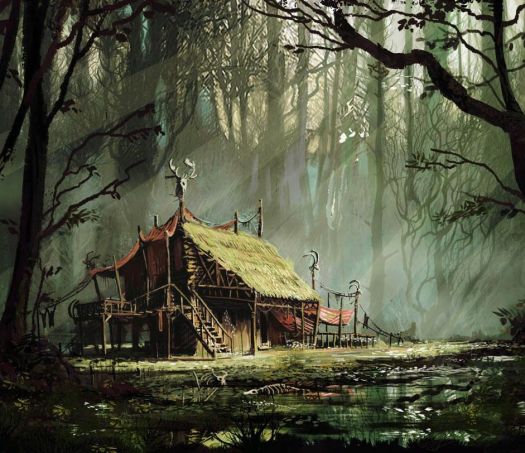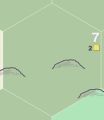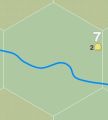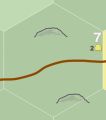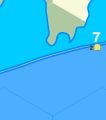Difference between revisions of "Type-7 Hex"
Tao alexis (talk | contribs) |
Tao alexis (talk | contribs) |
||
| Line 6: | Line 6: | ||
== 2 Bread == | == 2 Bread == | ||
[[File:7-2b.jpg|left|60px|thumb]] | [[File:7-2b.jpg|left|60px|thumb]] | ||
| − | These hexes are distinctive for a single element of humanoid existence: [[Farmland|farmland]]. Each hex has approximately 250 to 400 acres of plowed farmland, divided into 15-30 acre plots called [[Measurements#Land|bovates or virgates]]. The farmers that work these lands have staked out a claim based on their courage to farm wild, isolated areas — but for them, these places would be called "[[Type-8 Hex|wilderness]]." As such, these families don't "own" their land; but as no authority directly claims it, the residents have achieved a freedom of sorts. | + | These hexes are distinctive for a single element of humanoid existence: [[Farmland|farmland]]. Each hex has approximately 250 to 400 acres of plowed farmland, divided into 15-30 acre plots called [[Measurements#Land|bovates or virgates]]. The farmers that work these lands have staked out a claim based on their courage to farm wild, isolated areas — but for them, these places would be called "[[Type-8 Hex|wilderness]]." As such, these families don't "own" their land; but as no authority directly claims it, the residents have achieved a freedom of sorts. Total population for a hex like this is 50 to 80. |
Farms are laid out at a half-mile distance from one another, to make the most of foraging the nearby [[Hinterland|hinterland]] for [[Hunting (sage ability)|game]], [[Mushroom Hunt (sage ability)|mushrooms]] and other [[Foraging (sage ability)|forage]]. Each family dwells in a [[Hovel (dwelling)|hovel]] of their own construction, with unsheltered [[Gong Pit|gong]] boxes as amenities. Farms favour access to [[River|rivers]] or [[Roads & Routes|routes]] — if sizable examples of these exist — so it's not unlikely to find a string of farms following such courses. Otherwise, farms will make use of tiny brooks, [[Roads & Routes#Route Descriptions|paths and even trails]] if no more is available. | Farms are laid out at a half-mile distance from one another, to make the most of foraging the nearby [[Hinterland|hinterland]] for [[Hunting (sage ability)|game]], [[Mushroom Hunt (sage ability)|mushrooms]] and other [[Foraging (sage ability)|forage]]. Each family dwells in a [[Hovel (dwelling)|hovel]] of their own construction, with unsheltered [[Gong Pit|gong]] boxes as amenities. Farms favour access to [[River|rivers]] or [[Roads & Routes|routes]] — if sizable examples of these exist — so it's not unlikely to find a string of farms following such courses. Otherwise, farms will make use of tiny brooks, [[Roads & Routes#Route Descriptions|paths and even trails]] if no more is available. | ||
Revision as of 18:44, 12 December 2022
A type-7 hex is a designation used to describe populated area with the least amount of infrastructure possible, that being 1 point. With an area of 38.53 sq.miles, and a diameter of 6.67 miles, hexes of this type reflect a bare minimum of amenities, comforts and outside assistance. These individuals depend upon growing their own food for survival, striving to make the most of the land they occupy. Nonetheless, their small contributions of extra food to the world market helps sustain more sophisticated persons dwelling in the largest cities, where edibles are always needed.
Contents
The precise nature of a given type-7 hex depends upon more than this designation: it also depends upon symbols representing food production, wealth and facilities. Different amounts of development for "type-7" are stipulated by the amount of "bread," "coins" and "hammers" a given hex possesses. The lowest type-7 hex that can exist is one represented by 2 bread and nothing else.
2 Bread
These hexes are distinctive for a single element of humanoid existence: farmland. Each hex has approximately 250 to 400 acres of plowed farmland, divided into 15-30 acre plots called bovates or virgates. The farmers that work these lands have staked out a claim based on their courage to farm wild, isolated areas — but for them, these places would be called "wilderness." As such, these families don't "own" their land; but as no authority directly claims it, the residents have achieved a freedom of sorts. Total population for a hex like this is 50 to 80.
Farms are laid out at a half-mile distance from one another, to make the most of foraging the nearby hinterland for game, mushrooms and other forage. Each family dwells in a hovel of their own construction, with unsheltered gong boxes as amenities. Farms favour access to rivers or routes — if sizable examples of these exist — so it's not unlikely to find a string of farms following such courses. Otherwise, farms will make use of tiny brooks, paths and even trails if no more is available.
The most vigilant farmers can manage as many as 30 acres of crops a year, carrying their excess to garners located in thorps or hamlets, or even larger centres. Very rarely a family may be met by a tax farmer, who's entitled to seize produce in the name of the realm — though this must be done carefully if the official doesn't want to risk life and limb. Beyond such persons, a farmer might chance to encounter a party of bandits ... but as the farmer has nothing to steal, and potentially shelter to offer, usually arrangements are made between these disparate groups. A party of player characters stumbling across an isolated farm of this kind shouldn't wonder if the farmer is ready to barter food for difficult to obtain tools or unusual fancy items.
Examples
As suggested, these hexes may include features such as hills, streams or roads, like the dirt road in the third example. Note that it's entirely possible to find type-7 hexes like this along important trade routes or major roads, or against the banks of huge rivers. The very fact that the hex is designated type-7 indicates that the soil is less than ideal, yet capable of supporting a dozen families, more or less. The example fourth from the left shows a type-7 hex occupying a hex in which a sandbar separates the sea from a freshwater lagoon. The residents of this kind of topography would depend heavily on catch fishing.
2 Bread, 1 Hammer
These hexes only exist in places where navigable or semi-navigable rivers occur ("semi-navigable" describes a river that can be travelled in a rowboat, but is impractical for significant commercial traffic). A river of this time is at least 2 pts. wide on the game map. While the amount of farmland does not increase, hexes of this type include a thorp, which has the minimal services provided by a boat dock, garner, gristmill, ox tether and saw pit.
